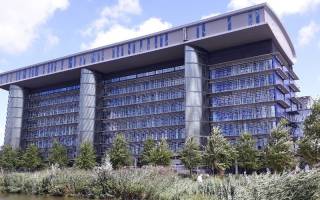Leiden University Medical Center (LUMC), Leiden, The Netherlands
Center Principal Investigators:

Dr Richard Lemmers, LUMC Lead of the FSHD genetic research subgroup
ICGNMD Role: FSHD Genetic Analysis of FSHD
E-mail: r.j.l.f.lemmers@lumc.nl

Professor Silvère van der Maarel, LUMC Head of the Human Genetics Department & FSHD Group Lead H3
ICGNMD Role: ICGNMD Group Leader, LUMC
E-mail: maarel@lumc.nl

- About LUMC
Leiden University Medical Center (LUMC) is the university hospital affiliated with Leiden University, constituting the university’s medical faculty. As a centre of medical innovation, LUMC has an internationally recognised leading role in improving the quality of healthcare. The core tasks of the LUMC are research, education, patient care, training and continuing education. Its mission is to improve healthcare and people’s health, and it seeks to deliver optimised, state-of-the-art healthcare based on leading research and innovation. Research foci include highly specialised “tertiary referral care” for patients with severe or rare diseases and disorders that are challenging to treat. LUMC is connected globally with other academic and medical centres of excellence, for example through participation in European Reference Networks.
- LUMC and the ICGNMD
ICGNMD has teamed up with LUMC to connect with its unique and world-leading expertise in the neuromuscular disease FSHD (Facioscapulohumeral Muscular Dystrophy). This disorder is a common cause of muscular dystrophy with a prevalence of approximately 1 in 20,000 people, that affects both males and females, with wide and complex symptoms. It is technically very difficult to run genetic tests for FSHD and the results are also challenging to interpret. The ICGNMD is delighted to connect with Professor Van der Maarel and Dr Lemmers, who contribute world-leading expertise in the testing, interpretation, treatment and underlying biology of FSHD to the ICGNMD. The LUMC team’s strong commitment to characterise the global prevalence and causes of FSHD means its investigators are perfectly aligned to the ICGNMD’s aims.
- Summary of Professor van der Maarel's current research programmes
Professor van der Maarel is Head of the Human Genetics department and FSHD Group Lead at LUMC. He studies the biological and medical consequences of incomplete repeat mediated epigenetic repression in humans. His research includes investigating the D4Z4 repeat array structure on human chromosomes 4q and 10q as a model for macrosatellite repeat instability in health and disease, as (epi)genetic modifications of this macrosatellite repeat are associated with facioscapulohumeral muscular dystrophy (FSHD). His work has led to key observations in the understanding of the pathogenic pathway underlying FSHD. For example, he demonstrated that FSHD has an unprecedented genetic disease mechanism caused by digenic inheritance of a D4Z4 repeat array contraction on chromosome 4 in cis with a polymorphic polyadenylation signal for the DUX4 retrogene encoded by the D4Z4 repeat unit (FSHD1; Science 2010), or by digenic inheritance of a mutation in the chromatin modifiers SMCHD1, DNMT3 or LRIF1 and the polymorphic DUX4 polyadenylation signal on chromosome 4 (FSHD2; Nat Genet 2012; Am J Hum Genet 2016, Neurology 2020). He also showed that a D4Z4 repeat array contraction, or mutations in one of these chromatin modifiers, leads to incomplete repeat mediated epigenetic repression of the cleavage stage and germline transcription factor DUX4 in skeletal muscle, which is normally silenced in somatic tissue. He demonstrated that D4Z4 repeat mediated epigenetic repression of the D4Z4 repeat array is evolutionary conserved (PLoS Genet, 2013) suggesting that D4Z4 is a human metastable epiallele, epigenetically unstable and modifiable loci resulting in phenotypic mosaicism between cells and between individuals. More recently, Professor van der Maarel’s work has shifted focus to molecular therapies for FSHD, by applying RNA therapy or Crispr-Cas9 base editing strategies (Mol Ther Nucl Acids 2021; 2x). His work extends to other diseases of incomplete repeat mediated epigenetic repression, such as ICF syndrome, for which we identified mutations in ZBTB24 (Am J Hum Genet, 2011), CDCA7 and HELLS (Nat Comm, 2015), also affecting the epigenetic stability of macrosatellite repeats.
- Summary of Dr Lemmers' current research programmes
Dr Lemmers leads the FSHD genetic research subgroup at the LUMC, which analyses the genetics of FSHD in approximately 250 cases per year. His primary research focus is FSHD cases with a complex genotype that is difficult to interpret by standard molecular diagnostic techniques available for FSHD. The group’s genetic analysis method is typically based on high molecular weight DNA isolation, pulsed-field gel electrophoresis and Southern blotting, as well as methylation analysis, molecular combing and mutation analysis of FSHD2 genes. Such genetic analyses have not only revealed complex rearrangements, but also the presence of FSHD-permissive (4qA) and non-permissive (4qB) haplotypes (Nature Genetics 2002). These studies also resulted in a major breakthrough pinpointing the DUX4 gene as the causative gene for FSHD (Unifying model for FSHD, Science 2010). Epigenetic mechanisms in FSHD are also studied, in particular CpG methylation of the D4Z4 repeat array and identified the major gene involved in FSHD2, SMCHD1 (Nature Genetics 2012) and the group was also involved in the identification of two other FSHD2 genes. Currently, Dr Lemmers’ group is focused on identification of genetic factors contributing to the inter- and intrafamilial clinical variability in FSHD1 and FSHD2. The lab’s work is highly compatible with the ICGNMD, having already studied D4Z4 haplotypes and rearrangements in the FSHD locus across several worldwide populations.
- Key FSHD publications by the LUMC ICGNMD PIs
1. Lemmers RJLF, van der Vliet PJ, Blatnik A, Balog J, Zidar J, Henderson D, Goselink R, Tapscott SJ, Voermans NC, Tawil R, Padberg GWAM, van Engelen BG, van der Maarel SM (2021) Chromosome 10q-linked FSHD identifies DUX4 as principal disease gene. J Med Genet. jmedgenet-2020-107041.
2. Hamanaka K, Šikrová D, Mitsuhashi S, Masuda H, Sekiguchi Y, Sugiyama A, Shibuya K, Lemmers RJLF, Goossens R, Ogawa M, Nagao K, Obuse C, Noguchi S, Hayashi YK, Kuwabara S, Balog J, Nishino I, van der Maarel SM. Homozygous nonsense variant in LRIF1 associated with facioscapulohumeral muscular dystrophy. (2020) Neurology. 94:e2441-e2447.
3. van den Boogaard ML, Lemmers RJ, Balog J, Wohlgemuth M, Auranen M, Mitsuhashi S, van der Vliet PJ, Straasheijm KR, van den Akker RF, Kriek M, Laurense-Bik ME, Raz V, van Ostaijen-Ten Dam MM, Hansson KB, van der Kooi EL, Kiuru-Enari S, Udd B, van Tol MJ, Nishino I, Tawil R, Tapscott SJ, van Engelen BG, van der Maarel SM. (2016) Mutations in DNMT3B Modify Epigenetic Repression of the D4Z4 Repeat and the Penetrance of Facioscapulohumeral Dystrophy. Am J Hum Genet. 98:1020-1009
4. Lemmers RJ, Tawil R, Petek LM, Balog J, Block GJ, Santen GW, Amell AM, van der Vliet PJ, Almomani R, Straasheijm KR, Krom YD, Klooster R, Sun Y, den Dunnen JT, Helmer Q, Donlin-Smith CM, Padberg GW, van Engelen BG, de Greef JC, Aartsma-Rus AM, Frants RR, de Visser M, Desnuelle C, Sacconi S, Filippova GN, Bakker B, Bamshad MJ, Tapscott SJ, Miller DG, van der Maarel SM. (2012) Digenic inheritance of an SMCHD1 mutation and an FSHD-permissive D4Z4 allele causes facioscapulohumeral muscular dystrophy type 2. Nat Genet. 44:1370-1374.
5. Lemmers RJ, van der Vliet PJ, Klooster R, Sacconi S, Camaño P, Dauwerse JG, Snider L, Straasheijm KR, Jan van Ommen G, Padberg GW, Miller DG, Tapscott SJ, Tawil R, Frants RR, van der Maarel SM (2010) A Unifying Genetic Model for Facioscapulohumeral Muscular Dystrophy. Science 329:1650-1653
6. Lemmers RJ, van der Vliet PJ, van der Gaag KJ, Zuniga S, Frants RR, de Knijff P, van der Maarel SM (2010) Worldwide population analysis of the 4q and 10q subtelomeres identifies only four discrete interchromosomal sequence transfers in human evolution. Am J Hum Genet. 86:364-377.
 Close
Close

